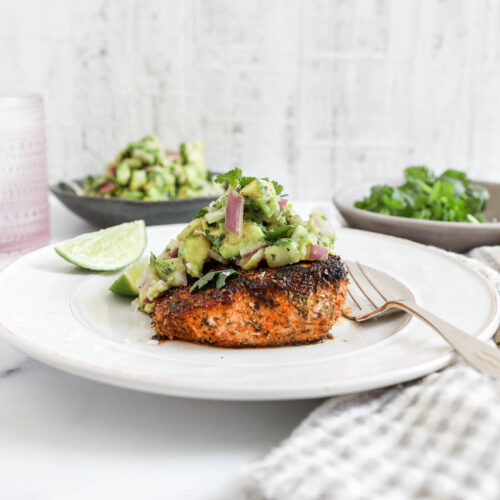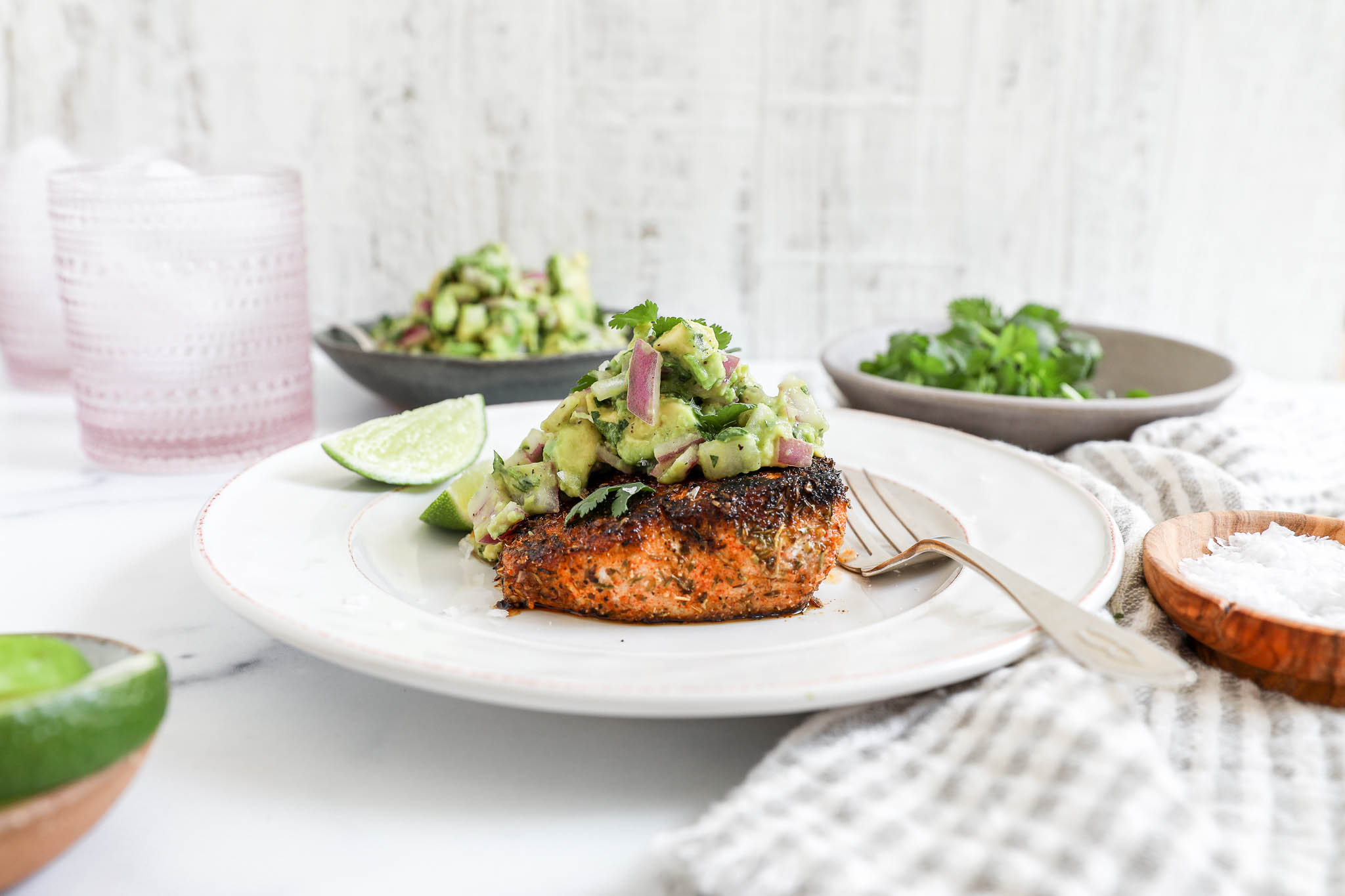Blackened Mahi Mahi with Guacamole.
Mahi mahi fillets coated in blackening seasoning then pan fried in butter until crispy on the outside and tender and flaky on the inside. The blackened fillets are topped with a simple creamy and cooling guacamole.

This blackened mahi dish was inspired by the many, many incredible blackened mahi mahi lunches and dinners that we have every year when we go to visit my parents in the Florida Keys. There’s something so intoxicating about the smell of blackening seasoning + butter + fresh fish. After having so many incredible fish dinners down South, I was determined to replicate the blackened mahi mahi at home. This dish comes pretty darn close to the incredible mahi in the Keys.
WHAT DOES IT MEAN TO BLACKEN FISH?
To blacken fish means to coat it in a blend of herbs and spices then pan fry it (often in a cast-iron skillet) in butter (or a combination of butter and oil) until the fish develops a dark “blackened” crust. Oftentimes, the herbs and spices used include: onion powder, garlic powder, dried thyme, dried oregano, paprika, cayenne pepper, black pepper and salt. We are not big fans of very spicy food, so I’ve omitted the cayenne in this blackening seasoning. Feel free to add cayenne to your liking.
WHAT IS MAHI MAHI?
Mahi mahi, also know as dorado or dolphinfish (though it is not a dolphin!), live in warm, tropical and subtropical waters – it’s a beautiful fish. According to FishWatch, 1/3 of the commercial fishing of mahi mahi comes from the Atlantic, Gulf of Mexico, and Caribbean and the remaining comes from the Pacific (majority from Hawaii).
Mahi is a mild, sweet tasting white fish. It has a dense, firm texture, yet is tender and succulent and holds up well to various cooking methods. Mahi is a lean fish, but you wouldn’t know it because it’s rich and moist.
When you purchase mahi mahi, the flesh will be light pink to greyish white with some darker meat near the blood line. For a milder flavor, you can trim off the darker flesh. When the fish is cooked, it will be white to off-white.
The skin on mahi mahi is beautiful, but is not edible, so you’ll want to remove it before eating. You’ll want to remove it prior to cooking in this recipe, so the blackening seasoning can impart its flavor on all sides of the fish. I had our local fish market, The Clam Man, remove the skin, so you’ll want to do the same at your fish counter. If you’re using frozen mahi mahi, the skin should already be removed.

Here’s what you’ll need to make this blackened mahi:
INGREDIENTS:
For the fish:
- mahi mahi fillets
- onion powder
- paprika
- garlic powder
- dried thyme
- dried oregano
- kosher salt
- black pepper
- canola or avocado oil
- salted butter
- lime wedges
For the guac:
- avocado
- red onion
- cilantro
- lime juice
- kosher salt
- black pepper
STEP-BY-STEP INSTRUCTIONS:
- Make the guacamole. Set aside.


- Combine herbs and spices (blackening seasoning) in a small bowl and mix well.

- Pat mahi mahi fillets dry. Sprinkle blackening season on the fish, all sides, pressing into the flesh.


- Add oil and butter to a large cast-iron skillet over medium high heat.
- When skillet is hot, add the fish.

- Cook fillets for 3-4 minutes, until a nice dark crust appears on one side. Flip mahi and cook another 3-4 minutes, until cooked through. Cooking time will vary depending on the thickness of the fillets.

- Serve mahi mahi with a dollop of chunky guacamole and lime wedges.
RECIPE FAQS for this blackened mahi mahi:
Is it hard to blacken fish?
Nope! Blackening is easy, you’re basically just putting a dry rub on your fish. The rub is made up of ingredients you likely already have in your spice cabinet – onion powder, garlic powder, paprika, cayenne, dried thyme, dried oregano, kosher salt and black pepper. Then, you’re pan frying in butter or a mixture of butter and oil. There’s a magic that happens when the blackening seasoning hits the butter, so use butter, not a butter substitute.
When blackening, make sure you turn on the exhaust fan and open any kitchen windows, as it’s a cooking method that tends to involve a lot of smoke.
Is this blackened fish spicy?
No. It’s highly spiced and flavorful, but it’s not spicy. You can easily add heat to this dish by adding cayenne – start with ¼ – ½ teaspoon of cayenne and adjust depending on your preferred spice level.
Is mahi mahi healthy?
Yes! Mahi mahi is rich in lean protein, B vitamins (including Vitamin B12, B6, niacin), phosphorous, potassium and selenium.
How do you know when mahi mahi is done?
Mahi mahi is cooked through when the internal temperature reaches about 140 degrees F in the center of the thickest part of the fillet with a meat thermometer. The temperature will continue to rise a few degrees once you remove it from the heat to a safe internal temperature of 145 degrees F. The fish will have turned from translucent flesh to white and opaque throughout and will flake easily with a fork. Cooking time will vary depending on the thickness of the filets.
Can you use frozen fillets?
Yes, you can use frozen mahi mahi fillets. Just be sure to thaw them completely by leaving them in the fridge overnight. I don’t recommend cooking fish or shellfish from frozen, as the texture really suffers.
What type of fish can you substitute for mahi mahi in this recipe?
Grouper, halibut, and snapper would be good substitutions. Adjust the cooking time, depending on the thickness of the fillets you choose.
Do you need to use a cast-iron skillet?
It’s not necessary, but recommended. And certainly, if you have one, pull it out for this recipe. The cast-iron will allow the blackened mahi to develop a beautiful dark crust that a non stick pan really cannot compare with. But, use what you’ve got. No need to purchase a new cast-iron skillet for this recipe.
Is mahi mahi a sustainable choice?
According to Fishwatch.gov, mahi mahi that is wild-caught in the US is a smart choice and is sustainable managed and responsibly harvested under US regulations. If the mahi mahi you are purchasing isn’t domestic, check Fishwatch.gov to determine if it’s a sustainable choice.

SIDE DISH SUGGESTIONS:
We love serving this blackened mahi mahi with one or more of the following:
- brown rice (or other whole grain)
- corn-on-the-cob
- whole grain rolls
- fresh corn and tomato salad
- large green salad
LOOKING FOR MORE EASY FISH DINNERS?


Blackened Mahi Mahi with Chunky Guacamole
Equipment
- 1 large cast-iron skillet
Ingredients
For the guacamole
- 2 avocados pitted and chunked
- 1/4 red onion diced
- 1/4 cup cilantro leaves roughly chopped
- 1 lime juice of
- 1/4 teaspoon kosher salt
- 1/4 teaspoon freshly ground black pepper
For the mahi mahi
- 24 ounces mahi mahi fillet (if frozen, thawed), skinless, cut into 4 fillets
- 1 teaspoon onion powder
- 1 teaspoon paprika
- 1 teaspoon garlic powder
- 1 teaspoon dried oregano
- 1 teaspoon dried thyme
- 1/2 teaspoon kosher salt
- 1/4 teaspoon ground black pepper
- 1 tablespoon canola or avocado oil
- 1 - 2 tablespoons salted butter
- 1 lime cut into wedges
Instructions
For the chunky guacamole
- Combine avocado chunks, red onion, cilantro, lime juice and salt and pepper. Adjust seasoning to your liking. Set aside.
For the mahi mahi
- To make the blackening seasoning, combine onion powder, paprika, garlic powder, thyme, oregano, salt and pepper together in a small bowl. Mix well.
- Using a paper towel or kitchen towel, pat the mahi fillets very dry on both sides. This will help the fish develop a nice crust.
- Sprinkle the blackening seasoning liberally on all sides of the fillets. Using your hands, press the seasoning into the fish.
- Add oil and butter to a large cast-iron skillet over medium high heat. (Be sure to turn the exhaust fan on and open kitchen windows, as blackening can create quite a bit of smoke.) When pan is hot, carefully add the fish. Cook fillets for 3-4 minutes, until a nice dark crust appears on one side. Flip mahi and cook another 3-4 minutes, until cooked through. Cooking time will vary depending on the thickness of the filets. Mahi is cooked through when the internal temperature reaches 135-140 degrees F in the center of the thickest part of the fillet, as measured with a meat thermometer. Fish will have turned from translucent flesh to white and opaque throughout and will flake easily with a fork.
- Remove from skillet.
- Serve mahi mahi with a dollop of chunky guacamole and lime wedges.
Nutrition
PIN this Blackened Mahi Mahi recipe for later:



Leave a Comment